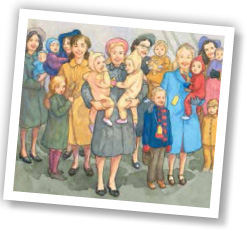
Author’s Note
After World War II, hundreds of thousands of war brides, also known as soldier brides, left their homelands for the United States to join their American husbands. Many of these women traveled on special ships, sometimes nicknamed “GI Bride Ships,” “Operation Diaper Run,” or “Stork Transports.” They came from more than 50 countries in different parts of the world, including countries in Europe and Asia, and from Australia.
After the war, most American soldiers were sent back to the United States. Usually, the non-American women who married American servicemen had to wait in their home countries for the government to make arrangements for them to join their husbands.
Leaving their homes for a new life in the United States wasn’t always easy for these war brides. (In fact, the Red Cross held classes for the brides on American cooking and customs.) Still, many thousands of women did make the trip on ships such as the Queen Mary, the Queen Elizabeth, the Argentina and others as they traveled from Europe, and on the Lurline and other ships from Australia. The Queen Mary alone carried more than 12,000 European war brides and babies to the U.S. and Canada from February to May of 1946.
Some trips proved very difficult. During rough weather, plates might slide down tables or the baby cribs might slide around the cabins. Many women became seasick. Countless others were homesick.
Upon arrival in the United States, these women faced adjustments as they adapted to a new culture. Some wartime marriages didn’t last, and the women returned to their native countries. Still, many of the unions were very happy, and many women enthusiastically embraced their new homeland.
